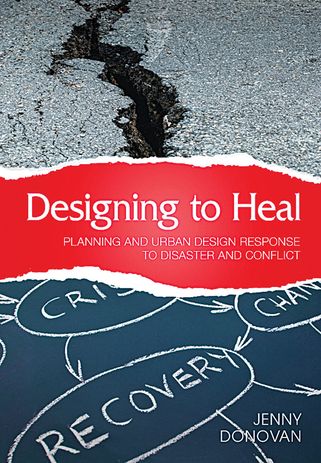As designers we aspire to know more, and to know better, than the client. After all, that is why we are hired. This aspiration also helps to justify the years, countless all-nighters and continuing professional development spent studying our craft. Jenny Donovan humbly and respectfully questions this in Designing to Heal: Planning and Urban Design Response to Disaster and Conflict. The book is written with the gentle hand of someone who has walked through the sites of trauma recounted in its pages. You realize quickly this gentleness, almost softness, in the narrative is a welcome counterbalance, as Donovan guides you through landscapes filled with grief, burdened by heartache and scarred by unimaginable loss.

Designing to Heal: Planning and Urban Design Response to Disaster and Conflict by Jenny Donovan.
The book examines aspects of urban design and landscape architecture that as designers, we rarely discuss: dealing with the emotional potential and consequences of our proposals. Never is this more heightened than during the aftermath of a disaster, when we are procured to help remaining communities rebuild. This is where the narrative of the book excels. With an analysis that is honest, candid and unbiased, it maps out the limitations of empathy, inadequacies of existing processes and the drawbacks of our influences. Who are we to think we can overlay our own interpretations upon other people’s connections with their identity and place? The book quietly reveals that while we may empathize with the emotions that may be felt, we actually know little about the spectrum of the human condition. More importantly, Designing to Heal allows us the opportunity to empower this lack of knowledge – to use our skills as designers to find other ways of designing within such landscapes.
The book opens with a clear introduction that measures its own limitations. It also successfully anchors the book within the accepted psychological paradigm of Abraham Maslow’s theory on human needs. This is an important point. Donovan does not pretend to know psychology and unlike the psychoanalytic discourses that dominated deconstructivism of the eighties and nineties and parametricism of this century, she does not attempt to appropriate theoretical overlays onto her studies. After all, the accepted convention of designers is that our work is our legacy and our signature is our style. It defines our life portfolio and over time, assures recognition. Through analysis, Donovan questions the validity of such luxurious conventions. In the aftermath of disaster what would you rather have: a theoretical interpretation by a stranger or a place you can identify with and call home?
Sitting in the comfort of our living rooms, we more than likely will assert that we are capable of achieving both and given the right circumstances, we probably can. Yet when faced with the more extreme end of the living spectrum, how relevant are these interpretations? How important are our theories to these communities and ultimately, if the fundamental drivers of respecting human dignity and their cultural heritage are not met, why should they care? As designers, we seek authorship. As communities, they are seeking home.
The editorial in Designing to Heal is precise and deserves acknowledgement. It would have been very easy to embellish, labour on the emotional, and overwrite the enormity of hardship suffered by these communities. Instead, the narrative is clear and well grounded. The case studies are from experience and firsthand accounts of the situations. This “reality” removes the discussion from the objective to the subjective and makes personal and tangible the range of complexities associated with working within these environments. They are at once inspiring and heartbreaking.
The design logic that supported the rebuild proposal for Hambantota, Sri Lanka in the aftermath of the 2004 tsunami is what most designers in the developed world would follow. This is what we know best. However, when imprinted into a developing country, a depressed economy, a population scarred by war and an ocean that on a clear day came from nowhere and destroyed everything, our developed-world-thinking holds limited value. It also highlights a compelling discussion beyond disaster recovery and into the implications of working with cultural, economic and socio-political differences. It stands as a clear reminder of the divide between what we know – which is in large based on our social and intellectual constructs, what governments and third parties aspire to – and, returning to Maslow, what the people on the ground truthfully need.
From the case studies, the absence of environmental psychology within our profession is palpable. To be diplomatic: sometimes we border on arrogance to presume we can design for a community we know little about. For a world increasing in disasters and crisis, this book is refreshing and enlightens us on how to design to heal. Rarely do we come across a design text that is rational and touching. Be touched by this.
Jenny Donovan, CSIRO Publishing, 2013, paperback, 320 pages. RRP $99.95.
Source

Discussion
Published online: 20 Apr 2014
Words:
Deborah Kuh
Issue
Landscape Architecture Australia, November 2013














